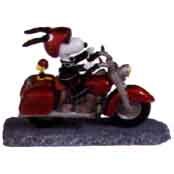
(PART II)
 I continued capturing images, one after the other. Inside the houses, on the gardens, the fountain, the rooms, the blown glass, the appliances, etc. Our guide insisted I was the one to open the main door to the new house just so I could feel how heavy it was. The new house was beautifully decorated and looked ready for someone to move in.
I continued capturing images, one after the other. Inside the houses, on the gardens, the fountain, the rooms, the blown glass, the appliances, etc. Our guide insisted I was the one to open the main door to the new house just so I could feel how heavy it was. The new house was beautifully decorated and looked ready for someone to move in.
After almost a full hour tour we finally said good bye to our guide and we headed towards the cemetery. A few more images and then we finally decided to go home, it is safe to say we were the last ones to leave the place.


All in all, a great tour worth repeating.



As one of the oldest cemeteries in southern California, El Campo Santo contains the remains of the pioneering Workman and Temple families as well as Pio Pico, the last governor of Mexican California. Within its low brick walls, the one-half acre cemetery features a Neoclassical mausoleum and a small cemetery plot surrounded by a Gothic Revival cast-iron fence.
In the early 1850s, the Workmans established El Campo Santo or "the sacred ground" as a cemetery solely for the use of their family. Along with a cemetery plot enclosed by an ornate cast-iron fence, they built a Gothic Revival brick chapel dedicated to St. Nicolas by Bishop Thaddeus Amat of Los Angeles. Among the first to be buried was William Workman's brother David, who was killed in 1855 while driving cattle to the gold fields in northern California.
At the turn of the century, the cemetery was abandoned and its brick chapel destroyed by fire. Walter Temple, a grandson of the Workmans, successfully filed a lawsuit preventing any further desecration of the cemetery. In 1917, he was able to purchase the cemetery and the surrounding 75 acres and began restoration. In place of the chapel, however, he built a cast stone Neoclassical mausoleum and moved the remains of his family inside. He also transferred the remains of Ygnacia and Pio Pico from Calvary Cemetery in Los Angeles, which was being relocated in the 1920s.
Today the cemetery is restored and maintained as a California State Historic Landmark and is open to visitors through a self-guided tour described in the free brochure available at the museum office.For additional information on the museum.
CLICK HERE!
.




3 comments:
Cemetaries are kinda creepy to me... but that's pretty!
As I keep saying, you do have a good eye for photography! These are all very beautiful -- each in their own way and for different reasons. I like the portrait one best of all because I would never have thought of shooting it from that angle.
michelle - Nothing creepy about this place, only beauty.
chris - I like the way the wall looked from top to bottom.
Post a Comment